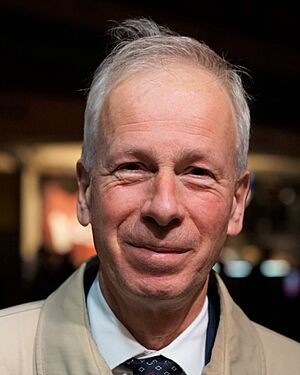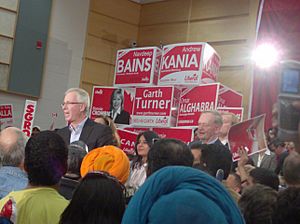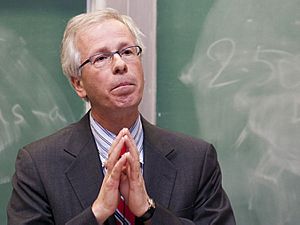Stéphane Dion facts for kids
Quick facts for kids
Stéphane Dion
|
|
|---|---|

Dion in 2021
|
|
| Canadian Ambassador to France and Monaco | |
| Assumed office 1 June 2022 |
|
| Prime Minister | Justin Trudeau Mark Carney |
| Preceded by | Isabelle Hudon |
| Special Envoy of Canada to the European Union |
|
| Assumed office 1 May 2017 |
|
| Prime Minister | Justin Trudeau Mark Carney |
| Preceded by | Position established |
| Canadian Ambassador to Germany | |
| In office 1 May 2017 – 1 June 2022 |
|
| Prime Minister | Justin Trudeau |
| Preceded by | Marie Gervais-Vidricaire |
| Succeeded by | Isabelle Poupart (acting) |
| Minister of Foreign Affairs | |
| In office 4 November 2015 – 10 January 2017 |
|
| Prime Minister | Justin Trudeau |
| Preceded by | Rob Nicholson |
| Succeeded by | Chrystia Freeland |
| Leader of the Opposition | |
| In office 2 December 2006 – 10 December 2008 |
|
| Preceded by | Bill Graham |
| Succeeded by | Michael Ignatieff |
| Leader of the Liberal Party | |
| In office 2 December 2006 – 10 December 2008 |
|
| Deputy | Michael Ignatieff |
| Preceded by | Bill Graham (interim) |
| Succeeded by | Michael Ignatieff |
| Minister of the Environment | |
| In office 20 July 2004 – 6 February 2006 |
|
| Prime Minister | Paul Martin |
| Preceded by | David Anderson |
| Succeeded by | Rona Ambrose |
| Minister of Intergovernmental Affairs | |
| In office 25 January 1996 – 11 December 2003 |
|
| Prime Minister | Jean Chrétien |
| Preceded by | Marcel Massé |
| Succeeded by | Pierre Pettigrew |
| President of the Queen's Privy Council for Canada | |
| In office 25 January 1996 – 11 December 2003 |
|
| Prime Minister | Jean Chrétien |
| Preceded by | Marcel Massé |
| Succeeded by | Denis Coderre |
| Member of Parliament for Saint-Laurent (Saint-Laurent—Cartierville; 1996–2015) |
|
| In office 25 March 1996 – 6 February 2017 |
|
| Preceded by | Shirley Maheu |
| Succeeded by | Emmanuella Lambropoulos |
| Personal details | |
| Born |
Stéphane Maurice Dion
28 September 1955 Quebec City, Quebec, Canada |
| Citizenship |
|
| Political party | Liberal |
| Spouse |
Janine Krieber
(m. 1986) |
| Children | 1 |
| Alma mater | Laval University (BA, MA) Sciences Po (PhD) |
| Signature |  |
Stéphane Maurice Dion (born 28 September 1955) is a Canadian diplomat, professor, and former politician. He has served as Canada's ambassador to France and Monaco since 2022. Before that, he was a key figure in Canadian politics for many years.
Dion was the leader of the Liberal Party and the Leader of the Opposition from 2006 to 2008. He held several important government jobs, called cabinet positions. These included being the minister for intergovernmental affairs, the environment, and foreign affairs. Before politics, he was a professor of political science.
Contents
Early Life and Education
Stéphane Dion was born in Quebec City, Quebec. His father, Léon Dion, was a well-known professor, and his mother, Denyse, was a real-estate agent from France. Because his mother was French, Dion has citizenship in both Canada and France.
As a young man, Dion was interested in the Quebec sovereignty movement, which wanted Quebec to become its own country. He even campaigned for the Parti Québécois, a party that supported this idea. However, after many discussions with his father, who believed in a united Canada, his views began to change.
He studied political science at Université Laval, where he met his future wife, Janine Krieber. After earning his degrees, he moved to Paris, France, to get his doctorate in sociology. He then became a professor at the Université de Montréal, where he taught from 1984 to 1996.
Political Career
In 1995, Quebec held a vote, called a referendum, on whether to separate from Canada. The "No" side, which wanted to stay in Canada, won by a very small amount. After this close vote, Prime Minister Jean Chrétien asked Dion to join his government.
Minister of Intergovernmental Affairs (1996–2003)
Dion was elected as a Member of Parliament in 1996. He was immediately made the Minister of Intergovernmental Affairs. His main job was to manage the relationship between the federal government and the provinces, especially Quebec.
The Clarity Act
Dion believed that the question in the 1995 referendum was confusing. He wanted to make sure that if a province ever voted to leave Canada again, the process would be clear.
He asked the Supreme Court of Canada for its opinion. The court said that a province could not just decide to leave on its own. It also said that if a province voted "Yes" on a clear question with a clear majority, the rest of Canada would have to negotiate with them.
Based on the court's ruling, Dion introduced the Clarity Act in 1999. This law sets out the rules for any future referendums on separation. It says the House of Commons of Canada must approve the referendum question and decide if the result is a "clear majority."
Minister of the Environment (2004–2006)
After Paul Martin became Prime Minister, Dion was not in the cabinet for a short time. However, after the 2004 election, Martin appointed him as the Minister of the Environment.
Dion was in charge of Canada's plan to follow the Kyoto Protocol, an international agreement to reduce pollution that causes climate change. In 2005, he led a major United Nations climate change conference in Montreal. This work earned him praise from environmental groups.
Leader of the Liberal Party (2006–2008)
In 2006, the Liberal Party lost the federal election, and Paul Martin stepped down as leader. Dion decided to run for the leadership of the party. His campaign focused on three main ideas: social justice, a strong economy, and protecting the environment.
At the leadership convention, Dion was not the favourite to win. He was in third place after the first vote. But after another candidate, Gerard Kennedy, dropped out and supported him, Dion gained momentum. He won the leadership on the fourth and final ballot.
2008 Federal Election

As leader, Dion proposed a major environmental policy called the "Green Shift." The plan was to create a new tax on carbon pollution. The money from this tax would be used to lower income taxes for people and businesses. The goal was to encourage everyone to pollute less.
The Green Shift became the main issue of the 2008 election. The Conservatives, led by Prime Minister Stephen Harper, attacked the plan, calling it a "tax grab."
The Liberals did not do well in the election. They won only 77 seats, down from 103. Dion took responsibility for the loss and announced he would resign as leader once a new one was chosen.
Later Political Career

Even after stepping down as leader, Dion remained a Member of Parliament. He was re-elected in the 2011 election, a difficult election for the Liberal Party. He continued to be an important voice for the party, especially on issues about Canadian unity.
When Justin Trudeau and the Liberals won the 2015 election, Dion was given a major role. He was appointed Minister of Foreign Affairs. In this job, he was Canada's top diplomat, responsible for the country's relationships with the rest of the world.
Diplomatic Career (2017–present)
In 2017, Dion left politics to become a diplomat. He was appointed as Canada's ambassador to the European Union and Germany.
In 2022, he was given a new role as the Canadian ambassador to France and Monaco. He continues to serve as a special envoy to the European Union, using his long experience in politics and government to represent Canada on the world stage.
Images for kids
-
Mirza Masroor Ahmad (left), leader of the Ahmadiyya Muslim Community, with Stéphane Dion (right) at the opening of the Baitun Nur mosque in 2008.
-
Stéphane Dion with U.S. Secretary of State John Kerry in Brussels, Belgium, in 2015.
See also
 In Spanish: Stéphane Dion para niños
In Spanish: Stéphane Dion para niños
- List of foreign ministers in 2017
- Université Laval







